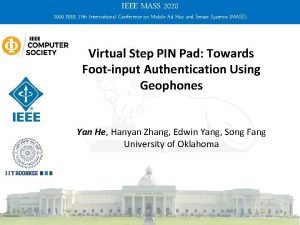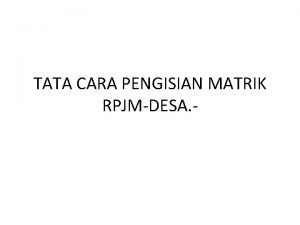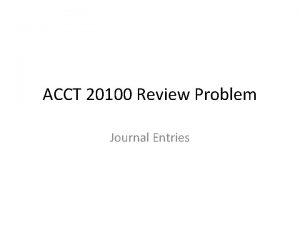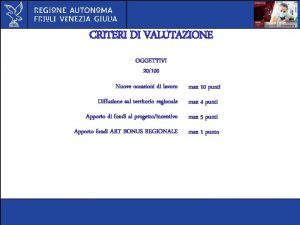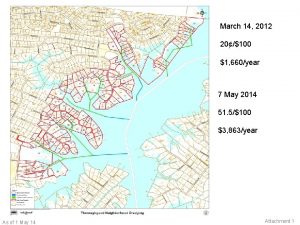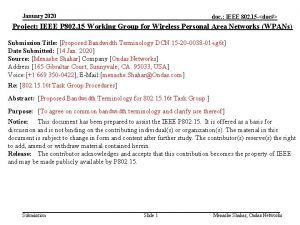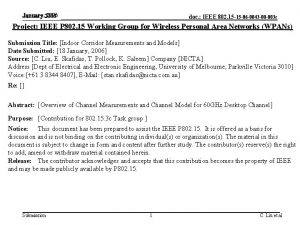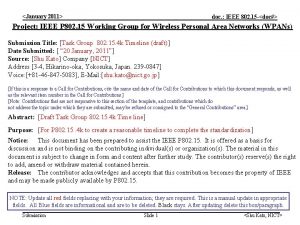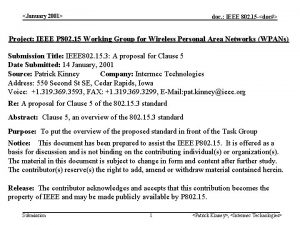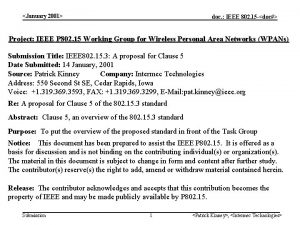January 2020 doc IEEE 802 11 20100 r











![January 2020 doc. : IEEE 802. 11 -20/100 r 0 References [1] 11 -19/514 January 2020 doc. : IEEE 802. 11 -20/100 r 0 References [1] 11 -19/514](https://slidetodoc.com/presentation_image_h2/be93691b3d5736f5e7273d65b941c96c/image-12.jpg)

- Slides: 13

January 2020 doc. : IEEE 802. 11 -20/100 r 0 Follow-Up on PHY Signaling for Adaptive Repetition of 11 p PPDU Date: 2020 -01 -13 Authors: Submission Slide 1 Rui Yang (Inter. Digital)

January 2020 doc. : IEEE 802. 11 -20/100 r 0 Introduction • TGbd has agreed that [1] “ 11 bd shall support adaptive repetition of 11 p PPDU when operating on OCB broadcast mode in 10 MHz bandwidth. The signaling of the adaptive repetition is TBD. The time between repeated 11 p PPDUs is TBD. ” • Since this agreement, several methods have been proposed • No PHY/MAC signaling [2] • MAC layer signaling [3] • PHY layer signaling [4] • In this document we provide additional simulation results for PHY layer signaling and possible ways to use it for the adaptive repetition of 11 p PPDU Submission Slide 2 Rui Yang (Inter. Digital)

January 2020 doc. : IEEE 802. 11 -20/100 r 0 Comparison of Different Methods • Direct method without additional PHY/MAC signaling [2] • Detect repetition directly from received signal • Repeated PPDUs need to be transmitted sequentially, separated by SIFS • Need for channel equalization – Performance and reliability depend on accuracy of channel estimation • Channel fading and interference will create degradation • MAC layer signaling [3] • Using Duration/ID field in MAC header to signal repetition related information • Does not need SIFS separation between the consecutive PPDUs • Cannot obtain combining gain, which is the original purpose of repetition transmission • PHY layer signaling [4] • Can be used to indicate repetition related information and detect if the PPDU was transmitted from an 11 p device or a 11 bd device • Repeated PPDUs need to be transmitted sequentially, separated by SIFS • Provide flexible and robust design Submission Slide 3 Rui Yang (Inter. Digital)

January 2020 doc. : IEEE 802. 11 -20/100 r 0 PHY Layer Signaling: Using Extra Tones in Frequency Domain • Using tones [-28, -27, 28] in some OFDM symbols to indicate, for example, 1) Received 11 p PPDU was transmitted from an 11 bd device by using energy detection 2) Repetition state (e. g. , first PPDU or last PPDU) by using simple sequence detection • Using those extra tones in data field may slightly impact data demodulation performance, but that can be mitigated by using lower power on those tones or by having more symbols with those extra tones • In [4], we used four OFDM symbols in data field and same power for all tones Submission Slide 4 Rui Yang (Inter. Digital)

January 2020 doc. : IEEE 802. 11 -20/100 r 0 Simulation Assumptions and Setup Preamble Submission Data Field Slide 5 Rui Yang (Inter. Digital)

January 2020 doc. : IEEE 802. 11 -20/100 r 0 Simulation Assumptions and Setup (cont. ) SNR Can be larger for high MCS … >2 or 5 d. B Noise -28 Submission 27 -27 Slide 6 28 frequency Rui Yang (Inter. Digital)

January 2020 doc. : IEEE 802. 11 -20/100 r 0 Additional Simulation Results (1/2) • Results with different number of symbols and power for the extra tones • A fixed ratio between the powers of an extra tone and a data tone is used for given (MCS, # of extra tone symbols, channel type) tuple, • e. g. -3 d. B for (16 QAM ½, 4 symbols, AWGN) • The ratio chosen provides extra tone with SNR > xd. B for the entire range of data PER for the given MCS and channel. • x=5 for 4 symbols and x=2 for 8 symbols • The worst-case miss and false probabilities are shown in the next page • Submission Slide 7 The extra tones have very negligible negative effects on Data PER Rui Yang (Inter. Digital)

January 2020 doc. : IEEE 802. 11 -20/100 r 0 Additional Simulation Results (2/2) False Alarm vs Detection for detecting legacy 11 p PPDU 1 -bit Detection Error Rate using Extra Tones • • • The BER of the 1 -bit info is shown for different number of symbols carrying extra tones • Total energy is the same for achieving the same reliability • AWGN BER is ~0 (not shown) The false alarm and detection probabilities (ROC curve) are bounded (to the upper-left corner) by the curves shown for the simulated MCS’s and channels Using more symbols with extra tones can improve the 1 -bit detection performance Submission Slide 8 Rui Yang (Inter. Digital)

January 2020 doc. : IEEE 802. 11 -20/100 r 0 Possible Repetition Transmitting and Receiving Procedures Transmitting Procedure • • PPDUs are transmitted sequentially, separated by SIFS Extra tones are used to indicate if this PPDU is the last one in the PPDU sequence • Define a flag “is. Last. Tx”: = 0 means this PPDU is not the last one; = 1 means this PPDU is the last one • Two groups of repetition transmissions are separated by a duration larger than SIFS Receiving Procedure • • Received PPDU may be any one in the sequence • Start-of-PPDU (SOP) detection is needed in the procedure Always decode the received PPDU first – decode the combined PPDU if necessary If a PPDU is decoded successfully, there is no need to decode the rest of received PPDUs Decoding of any PPDU doesn’t depend upon the detection of extra tones – the two operations can run in parallel is. Last. Tx 0 0 0 1 PPDU PPDU SIFS Submission SIFS Slide 9 >SIFS Rui Yang (Inter. Digital)

January 2020 doc. : IEEE 802. 11 -20/100 r 0 A Receiving Procedure If a PPDU is decoded successfully, no need to decode the rest of received PPDUs of the PPDU sequence Always decode the received PPDU first. Decode the combined PPDU if necessary. Submission Slide 10 Rui Yang (Inter. Digital)

January 2020 doc. : IEEE 802. 11 -20/100 r 0 Conclusion • In this contribution we provided addition simulation results for adaptive repetition transmission of 11 p PPDUs based on PHY layer signaling using extra tones in data field to mitigate the impact on data demodulation • Using lower power in the extra tones • Using more symbols with extra tones • Proposed procedures for transmission and reception of repeated 11 p PPDUs • The results show that PHY signaling using extra tones is a simple (in terms of signal processing), flexible and robust method, and able to obtain combining gain Submission Slide 11 Rui Yang (Inter. Digital)
![January 2020 doc IEEE 802 11 20100 r 0 References 1 11 19514 January 2020 doc. : IEEE 802. 11 -20/100 r 0 References [1] 11 -19/514](https://slidetodoc.com/presentation_image_h2/be93691b3d5736f5e7273d65b941c96c/image-12.jpg)
January 2020 doc. : IEEE 802. 11 -20/100 r 0 References [1] 11 -19/514 r 12, 802. 11 bd FRD SFD motion booklet [2] 11 -19/1946 r 0, Detection of adaptive repetitions [3] 11 -19/1847 r 4, Discussion on PHY/MAC Signaling for Adaptive Repetition of 11 p PPDU in 11 bd [4] 11 -19/1596 r 2, PHY Signaling for Adaptive Repetition of 11 p PPDU Submission Slide 12 Rui Yang (Inter. Digital)

January 2020 doc. : IEEE 802. 11 -20/100 r 0 SP Do you support using extra edge subcarriers of 11 p PPDU transmitted from 11 bd devices as a way to signal adaptive repetition? - Specific location of those extra subcarriers and the meaning of the signal are TBD Y/N/A: Submission Slide 13 Rui Yang (Inter. Digital)











